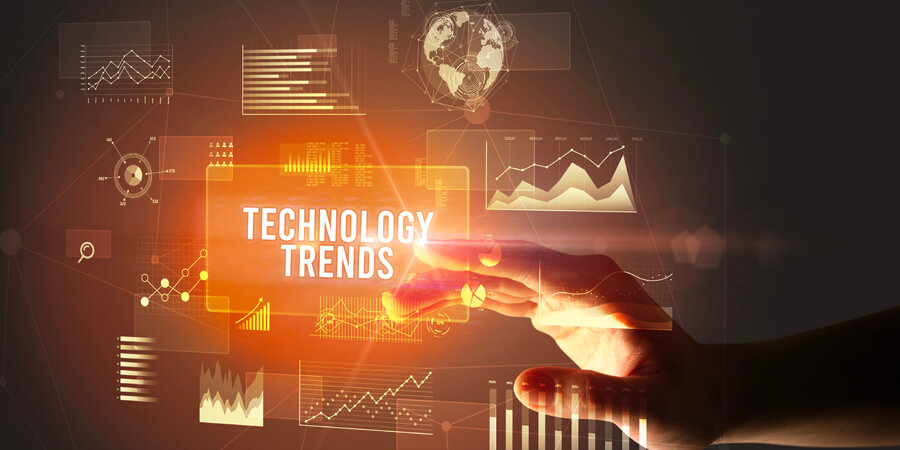As all digital things continue to accelerate, some technology trends matter more than others for companies and executives. While not always the coolest or most cutting-edge of the technologies, these high-value drivers draw the most venture capital and produce the most patent filings. They also have the biggest impact on how and where to compete as well as the capabilities needed to maximize performance and thus move into the future.
In the next decade, the world will experience more progress than in the past 100 years combined, as technology reshapes all sectors: telecom, health, sciences, energy, transportation and a wide range of other industries and domains. For instance, retailers will combine sensors, computer vision, AI, augmented reality and immersive and spatial computing to amaze customers with video-game-like experiences.
There are so many innovations and breakthroughs happening right now that are worth our closer look. The first trend is the future of connectivity which combines fifth-generation (5G) broadband cellular networks and the Internet of Things (IoT) to enable faster connectivity across longer distances, with exponentially faster downloads and a latency reduced to nearly nothing. From digitizing manufacturing (through the wireless control of mobile tools, machines and robots) to decentralized energy delivery and remote patient monitoring, the greater availability and capability of networks will dramatically change the business landscape. Implementing this trend in just four sectors – mobility, healthcare, manufacturing and retail – could increase global GDP by $1.2 trillion to $2 trillion by 2030, according to McKinsey research.
In addition, this trend offers superfast connectivity that has broad implications for organizations. It supports the creation of new services and business models linked to sensor-enabled intelligent products and produces new value-chain offerings like predictive and augmented-intelligence services, for example. Likewise, in mobility, IoT sensors and near-global coverage can be used to capture vehicle signals and track each system’s condition, allowing owners to schedule repairs well before mechanical failure and improving the durability and life span of vehicles.
This trend can be applied in several sectors including:
- Telecommunications: In a seamless network of IoT devices connected through 5G, a leading telco company has begun construction on a greenfield factory, utilizing industry-leading information and operational technology.
- Sports and entertainment: A sports stadium’s 5G upgrade has targeted real-time updates on players, improved security and introduced HD 360° augmented-reality replays for fans.
- Transportation: A Chinese railway station has used 5G for automated detection of station incidents and anomalies via IoT (for example, videos, and flow detection).
The second trend brings together cloud computing with edge computing to enable companies to reach data-hungry devices in a larger number of remote locations with far-less latency. This tech trend will help companies boost their speed and agility, reduce complexity, save costs and strengthen their cybersecurity defenses. Approximately 70 % of companies are using hybrid and multi-cloud management tools, processes and technologies in 2022. In order to reflect this shift toward distributed IT infrastructure, companies will source more software from cloud-service platforms and enterprise software-as-a-service providers (SaaS), from 23 % today to nearly 50 % in 2025, if current rates continue, with the potential to grow to 80 % in the future, according to the McKinsey research.
Moreover, this trend has business implications such as the democratization of IT infrastructure, especially computing power, and the shift in importance away from IT capabilities and towards software development. Driving this repositioning is the move to more centralized “as a service” (XaaS) models of delivery enabled by cloud technologies, as companies abandon more traditional on-premise IT infrastructures. This shift also suggests new, more modular configurations of business organizations built around platforms of activities and technologies that target specific business goals, including digital transformation, lower costs and higher innovation.
It is also possible to apply this trend to utilities, education and manufacturing. For example, one manufacturer used Internet of Things sensors at the edge with centralized cloud-based data centers to monitor and analyze maintenance issues in real-time, improving machinery maintenance efficiency, lowering maintenance costs and increasing asset value.
Last but not least is the trend of next-generation computing. Indeed, quantum computing and neuromorphic computing are gaining traction due to the development of specialized microchips called application-specific integrated circuits (ASICs). Such next-generation computing could help find answers to problems that have eluded science and society for years, unlocking unprecedented capabilities for businesses. It also promises to accelerate autonomous vehicle technology with quantum AI and transform cybersecurity, while reducing hardware costs in IT, quickening machine learning and enabling a more efficient search of unstructured data sets. This trend matters because next-generation computing will enable further democratization of AI-driven services, the quickening of development cycles and lower barriers of entry across industries. In addition, it promises the disruption of parts of the value chain, reshaping the skills and the approaches that are needed, e.g., automated trading replacing traditional traders.
This trend is applicable in urban logistics, as well, like optimizing traffic flow and reducing traffic jams both within and between cities. Next-generation computing can also be used in machine learning. For instance, Google offers tensor processing units (TPUs) as a cloud solution to bring machine-learning capabilities to the mass market, resulting in machine-learning applications that are 27 times faster at 38% lower costs versus graphics processing units (GPUs). Moreover, this can be applied to adaptive robotics; the growing ability of robots to sense, adjust and make independent decisions plays a crucial role in the Fourth Industrial Revolution (4IR).
The intensive efforts and exponential technological progress toward these trends create a wealth of opportunities that will allow people and companies to unleash the benefits of these developments for the entire society and for our common future.






